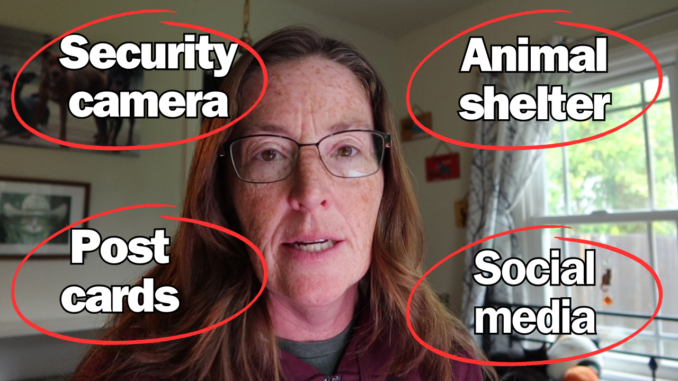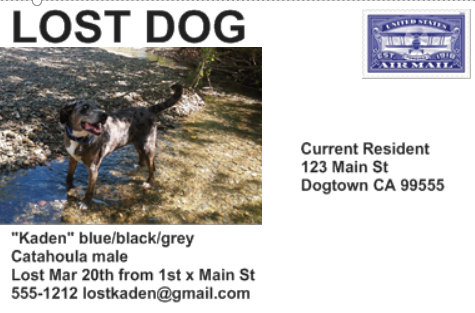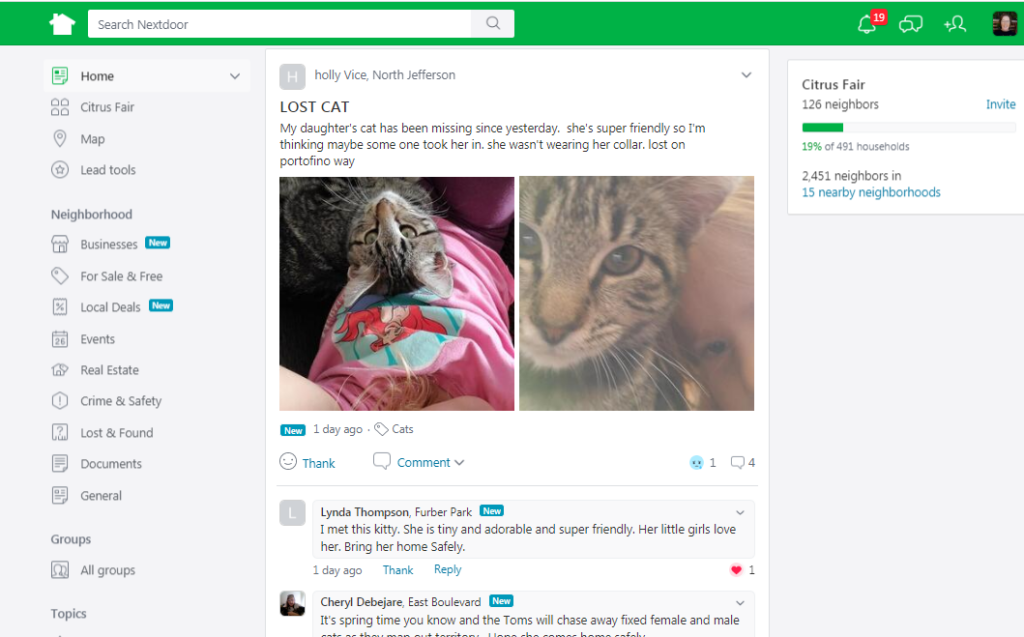
Learn how to generate leads, safely and effectively use traps, search animal shelters and rescue groups, and use the internet to find a pet who has been missing for a long time.
What is considered a long time?
A long time is a relative term, but for this scenario I would say that your pet has been missing for two weeks or more. Most pets are found within a day or a few days of becoming lost, so as the time passes you will need to rethink your strategy in order for it to be most effective. Many pets are found weeks, months, or even years after going missing, so try these tips and don’t lose hope!
Sightings
An important factor in your recovery strategy is sightings. Have you had sightings? What happened when you followed up on them? Were you able to confirm the sighting was indeed your cat or dog?
Update posters, flyers, and mailers
If you have had no good leads, or if the leads have diminished over time, the first thing you should do is update your posters, flyers, and mailers. After some time has passed, people will cease to notice the posters, and they may have set your flyer aside or thrown it in the trash. They will either forget about your search or assume you have found your pet, and give it no more thought.

New posters should be in a different color, and include the bold lettering STILL MISSING. This will attract the attention of folks who have not seen your posters and hopefully those who have seen them but now look the other way. Always include the text DO NOT CHASE. Well meaning folks may try to catch your pet, but you don’t want that. You just want them to call or text you right away. Even better if they can text you with a photo.
A good tool to help recover a pet missing for a long time is Every Door Direct Mail. Have you ever received a card in the mail advertising a local business, offering a special on dental cleaning, furniture, or some other product or service? This was likely sent through EDDM, a service provided by the Post Office. This service saves the sender a lot of time as it goes to every house and/or business in any area without the need to generate a mailing list or to address each mail piece, and it costs less than first class mail. Details on how to create and distribute an EDDM in the posters, flyers, and mailers article and video.

Follow up
When you get leads from any of these tools, follow up then concentrate your efforts. Especially after a long time, your pet may be far from where you may think he is, so you may need to extend your search. More than one valid lead in a given area is a good sign that your pet may indeed be there. You can do more intense door-knocking and handing out flyers in these areas to hopefully lead your closer to your lost pet.
The owner of kitty Zant (pictured) did just that and she was able to recover him! The sightings came from a different area than where she had been searching. She printed these cards and handed them out or put them under the door mats of everyone in the new search area. Thanks to that effort, she did find him.

Be aware of heartless scammers who have all sorts of tricks up their sleeves. They frequently get phone numbers from lost pet listings and prey on owners desperate for any information. Usually they ask for money right away and that’s a sure sign of a scam, but recently they have developed more sophisticated cons including cloning your phone number to scam others!
Question anyone who calls or texts you saying they have your pet, ask for photos and other proof, and never give your private information over the phone. If you are offering a reward, don’t hand over the money until your pet is safely in your hands. As eager as you may be for good news, use common sense and listen to your gut. If the story sounds fishy, it probably is.
Security camera

If you have sightings you’d like to confirm, or if you don’t have sightings but want to know if your pet is coming around when you’re not at home, a security camera can be a helpful tool. There are a variety of cameras available at different price points, some as low as $35.
Many owners have been surprised to see their missing pet where they did not expect to! Onion was one such kitty who was recovered after a long time thanks to the persistence of the family. They set up a number of security cameras until they confirmed her presence. She was too scared to come when they called, so they used a trap to safely get her back home.
Trapping
Do you know where your pet is but can’t catch him? Does he run away or hide when people are around? If so, a humane trap may be the tool to bring him safely home.
Cat traps can be purchased inexpensively or borrowed from a shelter or rescue group. If you don’t know how to use them, I recommend that you ask for assistance from a local cat rescue or TNR (Trap-Neuter-Return) group. There are a number of important considerations when using a cat trap, so please check out this article and video before proceeding.
Dog traps are large and costly, so you may want to ask for assistance from your local animal control. Some will help with dog trapping if they have the staffing and equipment. If they cannot help you, or if their efforts are futile, look for a dog trapping group near you.
The Retrievers Volunteer Lost Dog Team is one such group, and they have a wealth of information on their website about recovering lost dogs using traps. They are located in Minnesota and, according to their website, can only provide in-person service in their area. However, they may be able to provide remote consultation or to refer you to an individual or group near you.
Pet Detectives
There are a number of pet detectives offering a variety of services to the owners of missing pets. This kind of personalized assistance and guidance can be invaluable in focusing and directing your search. Many such services are conducted remotely, especially in this time of covid lockdown. Some services I would recommend are provided by Lost Cat Finder and Lost Pet Research and Recovery.
Some pet detectives offer search dog or tracking dog services which can be helpful in some situations. Proceed with caution before hiring someone for these services, as they can be quite pricey and are not a guarantee of finding your lost pet. Pet detectives run the gamut of quality just as in any other business, so do your homework. Check online for reviews and ask for references before investing in big ticket services.
A reputable pet detective with tracking dogs will start with a consultation to see if their services are right for you. Often, the consultation itself is the best tool. If it is determined that the dogs are appropriate for your situation, they will be upfront about the process, expectations, and cost of the service. A reputable pet detective will never guarantee to find a pet or claim their dogs can pick up a scent months or years after a sighting.
Check out this great comprehensive article from Lost Pet Research and Recovery on Using search dogs to find missing pets.
Animal shelter
Did you know that found pets can go up for adoption in as little as 72 hours? That’s right, just three days! In some parts of the country you have that short amount of time to realize your pet is missing, figure out which shelter to check, go there during business hours and complete the reclaim process. If not, your pet could be adopted by someone else, transferred to a rescue group or other shelter, or even put down.

Thanks to laws that haven’t been updated in over 100 years in the U.S., pet owners lose all rights after this mandated hold period. I have seen countless stories of desperate owners trying to get their lost pet back only to face a costly and likely losing legal battle.
Knowing this, it is critical that you check shelters right away and continue to do so even after a long time has passed. A found pet may turn up at a shelter weeks or months later for a variety of reasons. Often someone finds the pet and keeps it, whether with the intention of finding the owner or not. After some time, they decide they can’t keep the pet and surrender it to a shelter or rescue group. Sometimes these found pets escape again, then get picked up by animal control and brought to the shelter. This is how owners are miraculously reuniting with their pets many year later.
If it isn’t feasible for you to go physically to the shelter on a regular basis, keep in touch by checking online listings of found pets as well as adoptable pets. Because of those short hold periods, your pet could be in the shelter, but not in the stray section. Expand your search to animal control shelters further away, adoption-only humane societies, and rescue groups.
If your pet is microchipped, keep it registered! Contact the registry by phone or online, make sure the registration info is current and correct, and report your pet missing. many pets are found after a long time, even far from home, thanks to the microchip.
Internet
As discussed in Using technology to find a lost pet, the internet can be a helpful tool in your search. It can also be a waste of time if not used in a targeted manner.
Creating a Facebook page for your lost pet is a good way to get many more eyes and ears on your search, but there are some caveats.
You want to engage local residents on this page rather than people all over the country and world. There are well meaning folks who will share any animal rescue related post, but this won’t help you if the viewers aren’t in your area.
Facebook is free, but they create the algorithm, so you have no way of knowing who is seeing your posts. I have posted on pages with hundreds of followers yet the analytics say the post was seen by 5 or 10 people. Very frustrating.
Another way to get the word out is to create a website for your missing pet. There are many free WYSIWIG site builders out there like Weebly and Wix. Just add text, pictures, and links and you can have a decent looking website in under an hour. You can promote this website by creating an email list of animal-loving friends and associates in your area and sharing any updates. If you create a blog-style website (like this one) you can post updates as often as you like. Just like Facebook, but minus the weird algorithm and all the ads.
To avoid clogging your inbox with spam, and to respond immediately to leads on your missing pet, you can create an email account specifically for this purpose. For example, FindSashaHusky@gmail.com. There are many free email providers available like Gmail and AOL (yes, AOL is still around and I still use it!).
Nextdoor is a highly effective internet tool for finding lost dogs and cats. The key is its hyper-locality. Many times I see posts in my area where a pet is posted as lost, and found within days by a nearby neighbor. If your pet has been missing for a long time, definitely create a new post on Nextdoor and include the URL of any pages you have created for this purpose.

BEWARE a flood of helpers with good, but potentially harmful, intentions. I have seen some of these searches go viral, causing literal mobs of people to go out searching, doing all the wrong things like calling, clapping hands, and chasing. In once case, the lost dog ran into traffic in fear (he survived but lost a leg)! In any materials you create to aid your search, be sure to include in bold lettering DO NOT CHASE. CALL IMMEDIATELY (OR) TEXT A PICTURE.
Conclusion
Only you can decide when it is time to stop searching. Don’t let anyone judge you for continuing to search, or for deciding to stop. As time passes, you will use different methods, and you may not have as much time, as you need to get back to the other concerns in your life, but that’s not a reason to give up completely.




